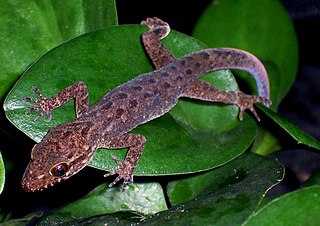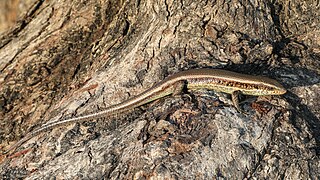
Gekko is a genus of Southeast Asian geckos, commonly known as true geckos or calling geckos, in the family Gekkonidae. Although species such as Gekko gecko are very widespread and common, some species in the same genus have a very small range and are considered rare or endangered.

Cyrtodactylus is a diverse genus of Asian geckos, commonly known as bent-toed geckos, bow-fingered geckos, and forest geckos. The genus has about 300 described species as of 2020, which makes it the largest of all gecko genera.

Parvoscincus is a genus of skinks, lizards in the family Scincidae. The genus is endemic to the Philippines.

Platymantis is a genus of frogs in the family Ceratobatrachidae. They are commonly known as wrinkled ground frogs, ground frogs, and forest frogs.

Eutropis is a genus of skinks belonging to the subfamily Mabuyinae. For long, this genus was included in the "wastebin taxon" Mabuya; it contains the Asian mabuyas. They often share their habitat with the related common skinks (Sphenomorphus), but they do not compete significantly as their ecological niches differ. This genus also contains the only member of the subfamily to occur in Australasia, the many-lined sun skink, whose wide range includes New Guinea.

The wildlife of the Philippines includes a significant number of endemic plant and animal species. The country's surrounding waters reportedly have the highest level of marine biodiversity in the world. The Philippines is considered one of the seventeen megadiverse countries as well as global biodiversity hotspot. In the 2000 Red List of the International Union for the Conservation of Nature and Natural Resources (IUCN), 418 of the country's 52,177 species were listed as threatened.

Sanguirana igorota is a species of true frog, family Ranidae. It is endemic to Cordillera Central of the island of Luzon, Philippines. Its closest relative is Sanguirana luzonensis, and it has even been considered synonym of that species; a later study suggests still unresolved relationships between S. igorota, S. luzonensis, and S. tipanan. Common name Taylor's Igorot frog has been coined for this species.

Calamaria gervaisii, commonly known as Gervais' worm snake, is a species of relatively small-sized burrowing or fossorial snake in the family Colubridae. This Snake feed on Earthworms and can grow maximum of 1FT or 30CM in length

Cyrtodactylus mamanwa is a species of gecko endemic to the Philippines. It was identified in 2010 from a sample collected in 2007 on the Dinagat Island and named after the Mamanwa indigenous group. It is also found on Siargao and nearby islands. Adults reach a total body length of ca. 19 cm. This gecko feeds mostly on insects and spends most of its life on trees. Females lay two brittle eggs under barks of trees or inside tree cavities.

Platymantis biak, also known as the Luzon limestone forest frog, is a species of frog in the family Ceratobatrachidae. It is endemic to the island of Luzon, the Philippines, where it is known from the Biak-na-Bato National Park, its type locality, and from the immediate vicinity of the park. The specific name biak is Tagalog meaning "crevice" or "crack" and refers to the preferred limestone karst habitat at the type locality.
Platymantis bayani is a species of frog in the family Ceratobatrachidae. It is endemic to the island of Samar, the Philippines. It is only known from its type locality, the Taft Forest Reserve in Taft, Eastern Samar. The specific name bayani is derived from the Tagalog word meaning "highly respected", "heroic", or "hero". The name honors Walter C. Brown, in recognition of his "numerous contributions to Philippine herpetology and … lifelong commitment to the study of biodiversity in the SW Pacific." Accordingly, common name Walter's limestone forest frog has been proposed for this species.
Cyrtodactylus sumuroi is a species of gecko, a lizard in the family Gekkonidae. The species is endemic to Samar in the Philippines.
Cyrtodactylus tautbatorum is a species of gecko, a lizard in the family Gekkonidae. The species is endemic to Palawan in the Philippines.

Cyclocoridae is a family of elapoid snakes endemic to the Philippines.
Gekko coi is a species of gecko, a lizard in the family Gekkonidae. The species is endemic to Sibuyan Island in the central Philippines.

Luperosaurus kubli is a species of gecko, a lizard in the family Gekkonidae. The species is endemic to Luzon in the Philippines.

Pseudogekko compresicorpus, also known as the Philippine false gecko or cylindrical-bodied smooth-scaled gecko is a species of geckos. It is endemic to the Philippines.
The Bicol false gecko is a species of gecko. It is endemic to the Philippines.
Danilo S. Balete, also known as Danny Balete, was a Filipino zoologist and biologist. His is known for his work on the Philippines' endemic mammal species. He pursued the question of what determines species diversity. The research by Balete and his team overturned previously held notions that diversity decreased in mountainous regions, showing that harsh environments could generate, rather than suppress, species diversity.
Pseudogekko hungkag, also known as the Bicol hollow-dwelling forest gecko, is a species of gecko. It is endemic to Bicol Peninsula of Luzon, the Philippines. It is a small gecko measuring 42–52 mm (1.7–2.0 in) in snout–vent length.














